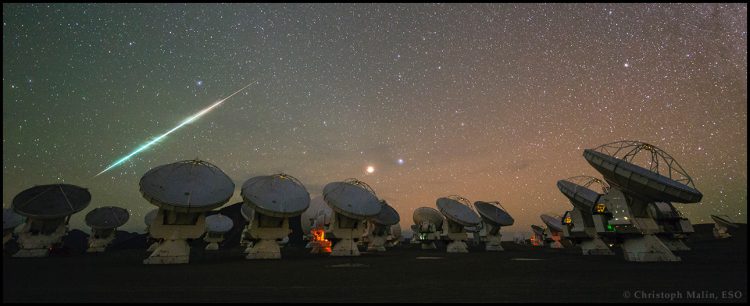Fireball Flares Above Watchful Eyes
Description
As seen on the National Geographic News high above the Chilean Andes, a fireball zooms past the high-precision antennas of a desert space observatory. The shooting star is just a bit of space dust burning up as it zips through the upper atmosphere, leaving a fiery wake. Beneath the meteor, some of the 66 antennas of the Atacama Large Millimeter/submillimeter Array (ALMA) observatory keep an eye on far more distant space phenomena from their perch some 5,000 meters (16,404 feet) above sea level. Just above the antennas, in the center of the image, Mars and the star Spica, the brightest star in the constellation Virgo, burn brightly in the night sky. Mars appears here near its brightest period in the Earth sky, when the Red Planet is at opposition with the Earth (happens every 26 months).
Located at the Chajnantor plateau, ALMA is considered as one of the most complex astronomical projects of our time. The antennas can operate together as a single giant telescope. ALMA is a partnership of Europe, North America and East Asia in cooperation with Chile. The site rarefied atmosphere, at about 50 percent sea level pressure, is also extremely dry. That makes it ideal for ALMA which is designed to explore the universe at wavelengths over 1,000 times longer than visible light. TWAN visit to ALMA was arranged by the European Southern Observatory (ESO), one of the main partner organizations of ALMA.

comments (1)
Hi dear Christopher.
May 4, 2014 at 11:53 amIt is so wonderful.
Thanks
Zohreh